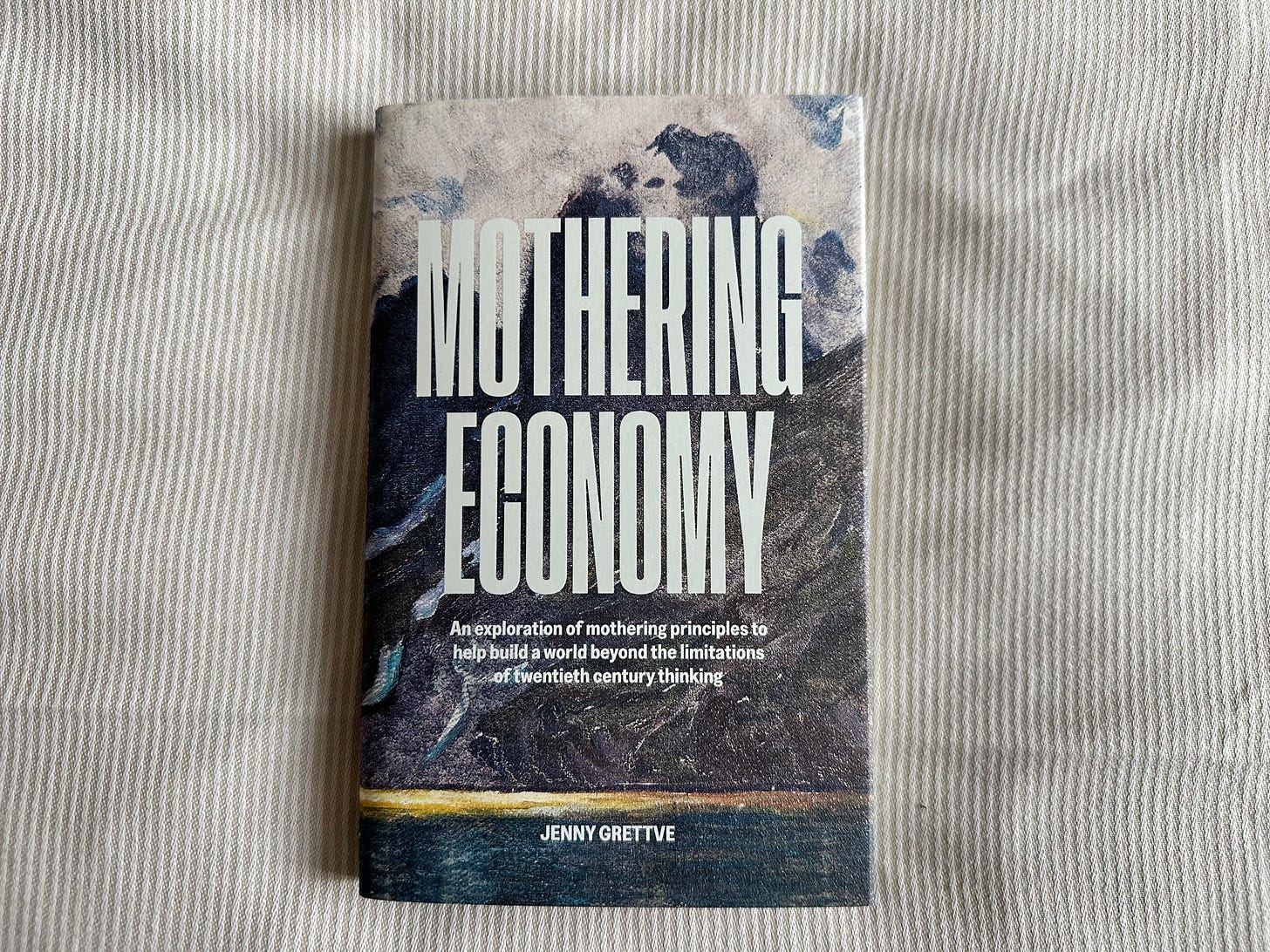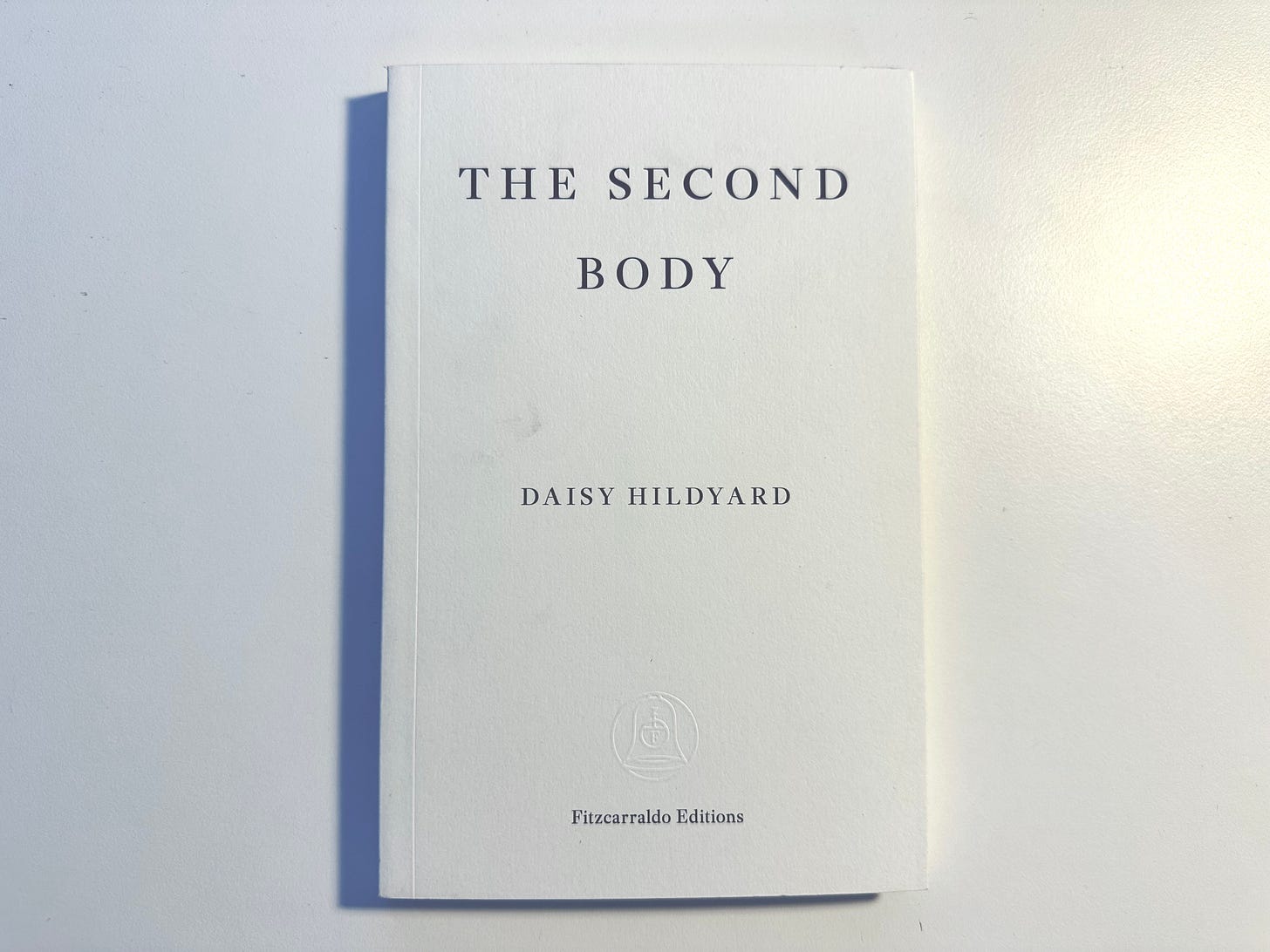First #11: Mothering Economy
Articulating mothering principles to make caring futures an imminent reality
Six principles of imaginative, practical and invigorating transformative change, bringing closer simpler futures that recentre our economies around care and generosity towards people and planet
🎉 First & Fifteenth is 1 year old today!
📚 You can buy Mothering Economy from Waterstones and Artdata (UK only) or directly from the publisher (International); for other books mentioned in this newsletter, go to my store on Bookshop.org

Are you weighed down by what feels like a looming and unescapable future defined by our technological overlords? Perhaps you are troubled by the environmental crisis accelerated by the expansion of generative AI? Or maybe it’s the rising tide of loneliness engulfing young and old alike, despite our inseparable attachment to algorithmic feeds.
If any (or all) of these solemn questions trouble you, then you might have found yourself lying awake at night, mentally searching for an answer in the quiet recesses of the night. It seems fitting that in the opening paragraph of Mothering Economy, its author Jenny Grettve begins her narrative journey in the same place. Wide awake at 2 am, asking “Why do we keep going?”
Mothering Economy is a tightly structured essay that sets out a practical manifesto of six mothering principles — each contributors to making alternative futures built on principles of care an imminent reality for people and planet.
In Grettve’s vision, care as a selfless act towards another are a practical demonstration of how mothering can transform how we live and work:
“Mothering as a way of being, when you take care of someone or something without conditions or restrictions but instead with enormous patience and warmth.” — Mothering Economy, pg. 17
In her vision, care given by mothering is not just a vague sentiment or indeterminate value tacked on as a topical remedy on top of ideologies that reify extractive economic models — systems under which we all labour in today’s technology and design industries.
Mothering principles
Structured around six mothering principles — Accept the flux of life; See the other; Rethink interdependent relationships; Care selflessly; Embody knowledge; Amend value systems — the unmistakable thrust of Mothering Economy is that this is a handbook written for practical and immediate action. A challenge that faces many writers when setting out visions of the future, is that the idea may be compelling, but readers are often left feeling at a loss for converting lofty ideals into action. Grettve disagrees:
“These principles can be applied to everything we do, anything we work with and to everything we see around us” — Mothering Economy, pg. 26
Putting mothering principles into action is inevitably transformative — both for ourselves and for the ecosystems within which we do our work. Mothering is not a concern limited only to women or mothers, in fact men are urged to take up this concern. Drawing on ecofeminist thinking, we are alerted to how the patriarchal systems from which our economies are constructed, are equal parts hierarchical, dominating, and exploitative — markers of success in most technological enterprises. Further iteration upon such foundations cannot realise the necessary acts of repair our planet sorely needs.
To adopt a matriarchal approach begins with recognising the limitations of our own imaginative vision and the interdependence of our existence with others — thinking that will transform how we recognise and contemplate the building blocks of our own technological and data landscapes, and the relationship our own bodies have with the planet — because we are slowly learning our bodies are far more connected to the cycles and rhythms of this Earth than we may like to admit to ourselves; so how can we continue to build bigger and more extractive systems to the detriment to the health of us all?
Inspiration is widely cited — ranging from Donna Haraway’s thinking on making kin with ourselves; to Gabor Maté’s writing on generational trauma and its feedback loop into consumerism; to Black Quantum Futurism and their work on rethinking approaches to space and time. The range of influences are a gift, affording us many loose threads to unravel so that we can satisfy our own inquisitive ends, or interrogate our own praxis.
By contemplating the vision set out in Mothering Economy, we experience discomfort. The clear articulation of futures grounded in feminist scholarship begins its analytical work by analysing the power, social, and political structures that have grown the metacrisis in which we find ourselves — leaving us to question our role in upholding its continuance.
Further contemplation of the vision presented in Mothering Economy engenders a sense of reassurance because Grettve writes from a position of self-awareness and vulnerability — by drawing attention to the cultural, social, and experiential gaps that are evident in her own lived experience of writing from a Scandinavian context — her admissions act as a reminder that futures thinking is particularly prone to producing exclusionary outcomes as a result of the personal myopias of its practitioners.
Interdependence

The cover of Mothering Economy is filled with details from “Fjordlandskap” by the Swedish artist Anna Boberg, who lived from 1836-1935. The exact dates of the painting (shown above) are unknown. Viewing the Norwegian landscapes were so consuming for Boberg that she spent years consumed by these views. She felt at one with the winds, the mists, and the cool sea breezes. Her embodied reaction to being immersed in nature is a tangible reminder to us, a few decades hence, of how much we have lost by being immersed in noisy cityscapes, our senses dulled by the airs and odours of every different kind.
Mothering Economy uses the art of Anna Boberg to set the scene before we have opened its covers. Our mind is set on refinding our interconnectedness and embodied response to being in nature: how we relate between ourselves, how the destructive action of one human can reverberate across the planet to afflict the life chances of another — seemingly unconnected and unrelated. Grettve asks:
“… how is Scandinavian GDP linked to the happiness of a school teacher in Bangladesh? How are relationships of different generations linked over a longer period of time? And how is an electric car in the UK linked to the dream of a child in Madagascar mining the minerals needed for that car's batteries?” — Mothering Economy, pg. 61
We do not have to dig deep to reveal how the technologies upon which we rely are tiny portals into sprawling technological ecosystems. Each tap and click results in a chain of events that cascade up a digital supply chain of which we have little sight. It is as if our real and digital selves exist in two bodies. Our corporeal beings move in parallel with and at a distance from our digital other.

The idea of a parallel corporeal existence is central to an essay of a very different persuasion — The Second Body by Daisy Hildyard (Fitzcarraldo Editions, 2017). While Hildyard’s work is mostly concerned with the ecological and ontological, it is the book’s poetic framing that alerted me to its thematic assonance with Mothering Economy. Considering the relation between our two bodies — inhabited and distant — Hildyard writes:
“… [how] each body is involved with every other living thing on earth. Your first body could be digesting a piece of bread in Lagos at precisely the same time as your second body is acting on the internal organs of a seagull in Kamchatka. The activity of a certain species of alga in the south Pacific has determined the composition of the air that you are breathing right now. For the second body, there is no stable boundary between one species and another: we're all in the same boat.” — The Second Body, pg. 57
We live and work in an economy that has trained us to be concerned only with the Self. We work alone in the belief our success is due to our brilliance as Individual Contributors. We are taught to think of design as the interaction between a single human and a single screen — all while the damage wrought by our extractive economies happens at a proximity that is barely perceivable within our field of vision. Our techno-critical myopia is ill-trained to recognise patterns of ecosystemic harm.
We can consider both Mothering Economy and The Second Body as companion pieces, because when read in unison, they leave us equipped to have a much clearer perception of our interdependence — among ourselves, towards our bodies (which Grettve remarks are interconnected “.. at a planetary scale … all the way down to our microbes”, pg. 77), and how the works of our hands leave indelible marks on the planet.
Mothering Economy Matters
Our online, print, and news media who report on technology is marshalled by a largely uncritical cohort of journalists who value access over analysis and construct uninquisitive narratives of techno-optimist futures. Broken and misshapen promises abound — of solving mass transit with individualised, on-demand, or autonomous transportation; colonising the Moon, Mars and beyond to solve our energy crisis; manufacturing a need for rapid grocery delivery; tokenising art; or the reduction of creativity to calculable chunks — the list can and will go on, so long as the investment and hype cycles continue.
To borrow the title of the closing chapter, “Mothering Economy Matters”. The message taps into the radical possibilities that mothering affords, both for its transformative potential and as a rebuke to the extractive and selfish ways in which we are socialised to recognise and reproduce economic success.
Mothering Economy gives us both the vocabulary, theoretical grounding, and visionary hope to strengthen our conviction that the alternative and desirable futures we strive towards are not the huge leap we may have feared.
Mothering Economy by Jenny Grettve. Published in 2024 by Plastic Letters Press, 158 pages. Support independent publishers and order directly; if that is not possible, ask your local bookshop to order it for you.
More from Jenny Grettve
Jenny has written on urban planning in REopening of a city (2021); fiction about modern womanhood in Abody Abode (2022); on the economy, gender, and systems thinking in Oh, what a way to die! (2023), and on property and ownership in Belongings & Ownership, with Matt Prewitt (2023), which she also made available as a free eBook.
In addition to her writing, Jenny directs When!When! — a feminist design agency based in Malmö, that put the principles of Mothering Economy into practice, with innovative projects delivered across education, food systems, construction, imagining future cities, and much more.
In “Feminist Economies”, presented at The Conference in Malmö in August 2023, Jenny sets out an early vision of what has become this book, of realising a feminist, matriarchal economy built around care and kindness — asking important questions about its practical effects on our work and businesses.
First #7: The Good Robot
Critical feminist thinking on technology that examines power, and imagines non-binary, anti-racist and decolonial futures
Explore further
Listen
Transcripts are available for War on the Air: Ecologies of Disaster - Daisy Hildyard, and Designing with Nature, with Emīlija Veselova.
Read
Staying with the Trouble: Making Kin in the Chthulucene by Donna J. Haraway (Duke University Press, 2016, 312 pages)
The Second Body by Daisy Hildyard (Fitzcarraldo Editions, 2017, 128 pages)
Lenses of Care – revisiting interconnectedness in service design by Kirsi Hakio, Tuuli Mattelmäki, and Emīlija Veselova (from Design Revolutions: IASDR 2019 Conference Proceedings, vol. 4, pages 144-155)
Black Feminist Ecological Thought: A Manifesto by Chelsea Mikael Frazier (from Atmos, 2020)
Feminist City: Claiming Space in a Man-Made World by Leslie Kern (Verso Books, 2020, 225 pages)
Data Feminism by Catherine D’Ignazio and Lauren F. Klein (MIT Press, 2020, 314 pages; also available as a free eBook under Open Access)
Feminist Designer: On the Personal and Political in Design by Alison Place (MIT Press, 2023, 247 pages)
The Slow Grind: Practising Hope and Imagination (The Laundry Arts, 2023)
Gathering: Women of Colour in Nature edited by Durre Shahwar and Nasia Sarwar-Skuse (404 Ink, 2024, 177 pages)




Happy 1st Birthday! 🎂
Mine is on Sunday! Well done us! 👏
I thought your Substack title was such an ambitious posting schedule, seriously well played if you've managed to stick to it for a whole year! 😳
PS: Rumour has it the Substack London Xmas Meet-up is on 4 Dec, hopefully see you there! 🤓
Going to be diving into your podcast recs, thanks Michael and happy first anniversary!